Thursday, 31 March 2016
Wednesday, 30 March 2016
Altaqwa College Indonesia Curriculum
March 30, 2016
Academic, Altaqwa College, Classroom, Year 10, Year 11, Year 12, Year 7, Year 8, Year 9
No comments
Secondary 1 - SMP
Year 7
- English (Cambridge) Semester 1, semester 2,
- Bahasa Indonesia Semester 1, semester 2
- Civics Semester 1, semester 2,
- Semester 1, semester 2
- AlQuran Semester 1, semester 2, Feedback
- ICT Semester 1, semester 2
- Arabic Semester 1, semester 2
- Islamic Studies (AlTaqwa) Semester 1, semester 2
- Social Studies Semester 1, semester 2
- Physical Education Semester 1, semester 2
- Character Building (Adaab, Life Skill, Art, etc) Semester 1, semester 2
Year 8
- English Semester 1, semester 2
- Bahasa Indonesia Semester 1, semester 2
- Civics Semester 1, semester 2
- Science Semester 1, semester 2
- AlQuran Semester 1, semester 2, Feedback
- ICT Semester 1, semester 2
- Arabic Semester 1, semester 2
- Islamic Studies Semester 1, semester 2
- Mathematics Semester 1, semester 2
- Social Studies Semester 1, semester 2
- Physical Education Semester 1, semester 2
- Character Building (Local Culture - Sunda, Adaab, Life Skill, Art, etc) Semester 1, semester 2
Year 9
- AlQuran Semester 1, semester 2
- Science Semester 1, semester 2
- English Semester 1, semester 2
- ICT Semester 1, semester 2
- Mathematics Semester 1, semester 2
- Bahasa Indonesia Semester 1, semester 2
- Social Studies Semester 1, semester 2
- Islamic Studies Semester 1, semester 2
- Civics Semester 1, semester 2
- Arabic Semester 1, semester 2
- Physical Education Semester 1, semester 2
- Character Building (Local Culture - Sunda, Adaab, Life Skill, Art, etc) Semester 1, semester 2
Year 10
- Chemistry Semester 1, semester 2
- Social Studies (Geography, Sociology) Semester 1, semester 2
- Economy Semester 1, semester 2
- AlQuran Semester 1, semester 2
- Biology Semester 1, semester 2
- ICT Semester 1, semester 2
- Islamic Studies Semester 1, semester 2
- Arabic Semester 1, semester 2
- Physical Education Semester 1, semester 2
- Character Building (Local Culture - Sunda, Adaab, Life Skill, Art, etc) Semester 1, semester
- Geography semester 1 , semester 2
- Sociology semester 1, semester 2
Year 11
- Chemistry* Semester 1, semester 2
- Social Studies (Geography, Sociology)* Semester 1, semester 2
- Economy* Semester 1, semester 2
- Physics* Semester 1, semester 2
- Mathematics Semester 1, semester 2
- AlQuran Semester 1, semester 2
- Biology* Semester 1, semester 2
- ICT* Semester 1, semester 2
- Islamic Studies Semester 1, semester 2
- History Semester 1, semester 2
- Arabic Semester 1, semester 2
- Civics Semester 1, semester 2
- Physical Education Semester 1, semester 2
- Character Building (Local Culture - Sunda, Adaab, Life Skill, Art, etc) Semester 1, semester 2
- Geography semester 1 , semester 2
- Sociology semester 1, semester 2
* Elective Subjects
Year 12
- Chemistry* Semester 1, semester 2
- Social Studies (Geography, Sociology)* Semester 1, semester 2
- Economy* Semester 1, semester 2
- Physics* Semester 1, semester 2
- Mathematics Semester 1, semester 2
- AlQuran Semester 1, semester 2
- English Semester 1, semester 2
- Biology* Semester 1, semester 2
- ICT* Semester 1, semester 2
- Islamic Studies Semester 1, semester 2
- History Semester 1, semester 2
- Arabic Semester 1, semester 2
- Civics Semester 1, semester 2
- Physical Education Semester 1, semester 2
- Character Building (Local Culture - Sunda, Adaab, Life Skill, Art, etc) Semester 1, semester 2
* Elective Subjects
Monday, 21 March 2016
A level Math Series - Binoial Theorem
Binomial Theorem
What happens when you multiply a binomial by itself ... many times?
Here is the answer:

Don't worry ... I will explain it all!

Don't worry ... I will explain it all!
And you will learn lots of cool math symbols along the way.
Binomial
A binomial is a polynomial with two terms
 |
| example of a binomial |
Multiplying
The Binomial Theorem shows what happens when you multiply a binomial by itself (as many times as you want).
It works because there is a pattern ... let us see if we can discover it.
Exponents
But first you need to know what an Exponent is.
Here is a quick summary:
An exponent says how many times to use something in a multiplication.
| 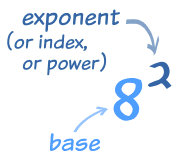 |
Example: 82 = 8 × 8 = 64
An exponent of 1 means just to have it appear once, so you get the original value:
Example: 81 = 8
An exponent of 0 means not to use it at all, and we have only 1:
Example: 80 = 1
Exponents of (a+b)
Now on to the binomial.
We will use the simple binomial a+b, but it could be any binomial.
Let us start with an exponent of 0 and build upwards.
Exponent of 0
When an exponent is 0, you get 1:
(a+b)0 = 1
Exponent of 1
When the exponent is 1, you get the original value, unchanged:
(a+b)1 = a+b
Exponent of 2
An exponent of 2 means to multiply by itself (see how to multiply polynomials):
(a+b)2 = (a+b)(a+b) = a2 + 2ab + b2
Exponent of 3
For an exponent of 3 just multiply again:
(a+b)3 = (a+b)(a2 + 2ab + b2) = a3 + 3a2b + 3ab2 + b3
We have enough now to start talking about the pattern.
The Pattern
In the last result we got:
a3 + 3a2b + 3ab2 + b3
Now, notice the exponents of a. They start at 3 and go down: 3, 2, 1, 0:

Likewise the exponents of b go upwards: 0, 1, 2, 3:

If we number the terms 0 to n, we get this:
| k=0 | k=1 | k=2 | k=3 |
| a3 | a2 | a | 1 |
| 1 | b | b2 | b3 |
Which can be brought together into this:
an-kbk
How about an example to see how it works:
Example: When the exponent, n, is 3.
The terms are:
| k=0: | k=1: | k=2: | k=3: |
|---|---|---|---|
| an-kbk = a3-0b0 = a3 | an-kbk = a3-1b1 = a2b | an-kbk = a3-2b2 = ab2 | an-kbk = a3-3b3 = b3 |
It works like magic!
Coefficients
| So far we have: | a3 + a2b + ab2 + b3 |
| But we really need: | a3 + 3a2b + 3ab2 + b3 |
We are missing the numbers (which are called coefficients).
Let's look at all the results we got before, from (a+b)0 up to (a+b)3:
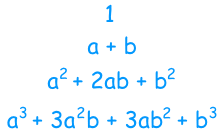
And now look at just the coefficients (with a "1" where a coefficient wasn't shown):
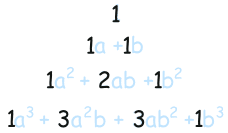
They actually make Pascal's Triangle!
Each number is just the two numbers above it added together (except for the edges, which are all "1")
(Here I have highlighted that 1+3 = 4)
| 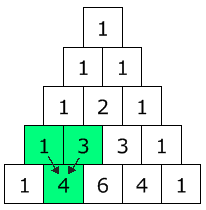 |
Armed with this information let us try something new ... an exponent of 4:
| a exponents go 4,3,2,1,0: | a4 | + | a3 | + | a2 | + | a | + | 1 | ||
| b exponents go 0,1,2,3,4: | a4 | + | a3b | + | a2b2 | + | ab3 | + | b4 | ||
| coefficients go 1,4,6,4,1: | a4 | + | 4a3b | + | 6a2b2 | + | 4ab3 | + | b4 |
And that is the correct answer.
We have success!
We can now use that pattern for exponents of 5, 6, 7, ... 50, ... 112, ... you name it!
That pattern is the essence of the Binomial Theorem.
Now you can take a break.
When you come back see if you can work out (a+b)5 yourself.
Answer (hover over): a5 + 5a4b + 10a3b2 + 10a2b3 + 5ab4 + b5
As a Formula
Our last step is to write it all as a formula.
But hang on, how do we write a formula for "find the coefficient from Pascal's Triangle" ... ?
Well, there is such a formula:
 |
It is commonly called "n choose k" because it is how many ways to choose k elements from a set of n.
You can read more at Combinations and Permutations
The "!" means "factorial", for example 4! = 1×2×3×4 = 24
|
And it matches to Pascal's Triangle like this:
(Note how the top row is row zero
and also the leftmost column is zero!) | 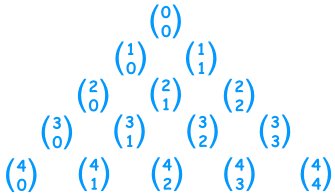 |
Example: Row 4, term 2 in Pascal's Triangle is "6".
Let's see if the formula works:

Yes, it works! Try another value for yourself.
Putting It All Together
The last step is to put all the terms together into one formula.
But we are adding lots of terms together ... can that be done using one formula?
Yes! The handy Sigma Notation allows us to sum up as many terms as we want:

Sigma Notation
Now it can all go into one formula:

The Binomial Theorem
Use It
OK ... it won't make much sense without an example.
So let's try using it for n = 3 :

BUT ... it is usually much easier just to remember the patterns:
- The first term's exponents start at n and go down
- The second term's exponents start at 0 and go up
- Coefficients are from Pascal's Triangle, or by calculation using n!/(k!(n-k)!)
Like this:
Example: What is (x+5)4
| Start with exponents: | x450 | x351 | x252 | x153 | x054 |
| Include Coefficients: | 1x450 | 4x351 | 6x252 | 4x153 | 1x054 |
Then write down the answer (including all calculations, such as 4×5, 6×52, etc):
(x+5)4 = x4 + 20x3 + 150x2 + 500x + 625
You may also want to calculate just one term:
Example: What is the coefficient for x3 in (2x+4)8
The exponents for x3 are:
(2x)345
The coefficient is "8 choose 5". We can use Pascal's Triangle, or calculate directly:
| n! | = | 8! | = | 8! | = | 8×7×6 | = 56 |
| k!(n-k)! | 5!(8-5)! | 5!3! | 3×2×1 |
And we get:
56(2x)345
Which simplifies to:
458752 x3
A large coefficient, isn't it?
And one last, most amazing example:
Example: A formula for e (Euler's Number)
You can use the Binomial Theorem to calculate e (Euler's number).
e = 2,718281828459045... (the digits go on forever without repeating)
It can be calculated using:
(1 + 1/n)n
(It gets more accurate the higher the value of n)
That formula is a binomial, right? So let's use the Binomial Theorem:

First, we can drop 1n-k as it is always equal to 1:

And, quite magically, most of what is left goes to 1 as n goes to infinity:

Which just leaves:
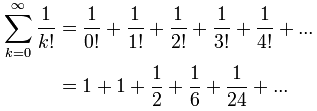
With just those first few terms we get e ≈ 2,7083...
Try calculating more terms for a better approximation!











.jpg)





